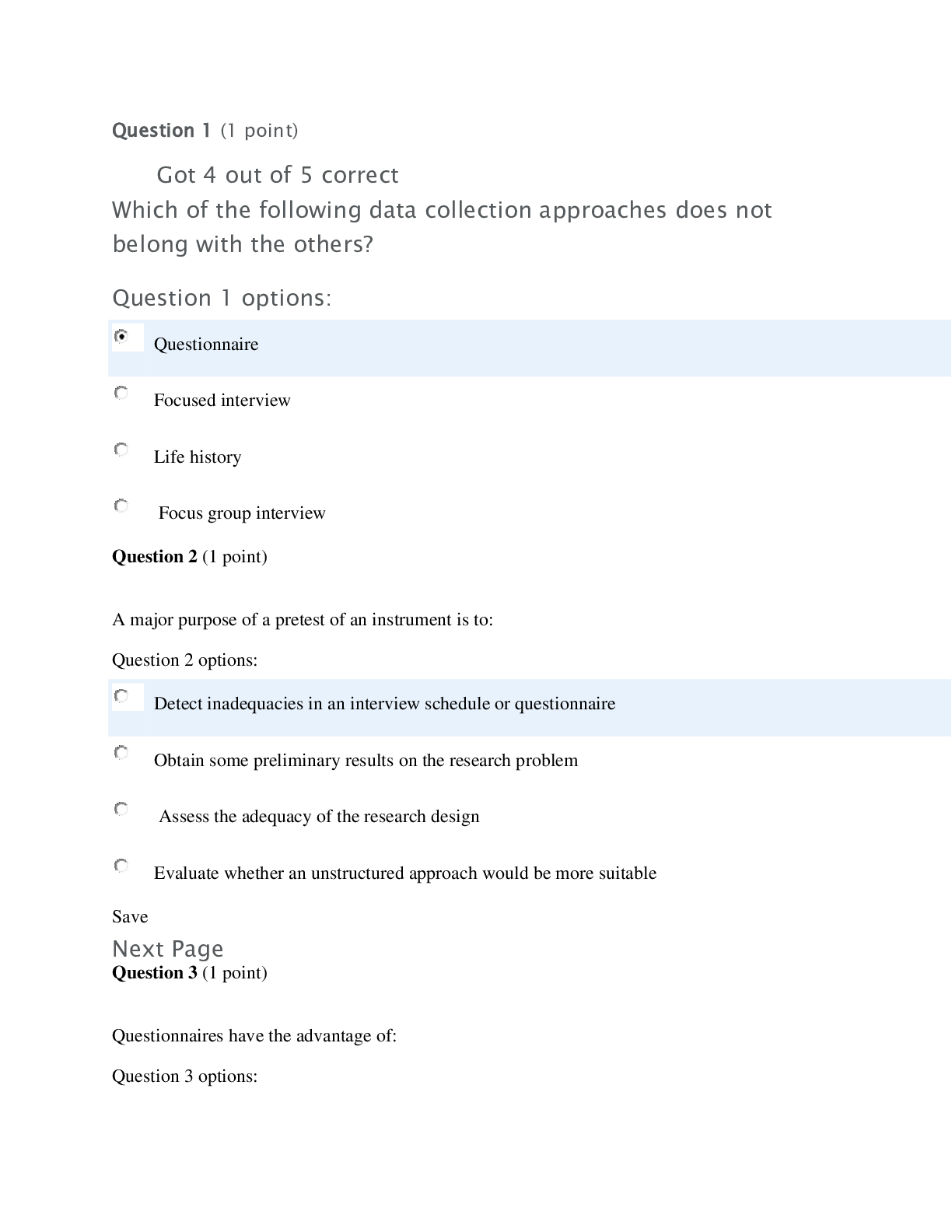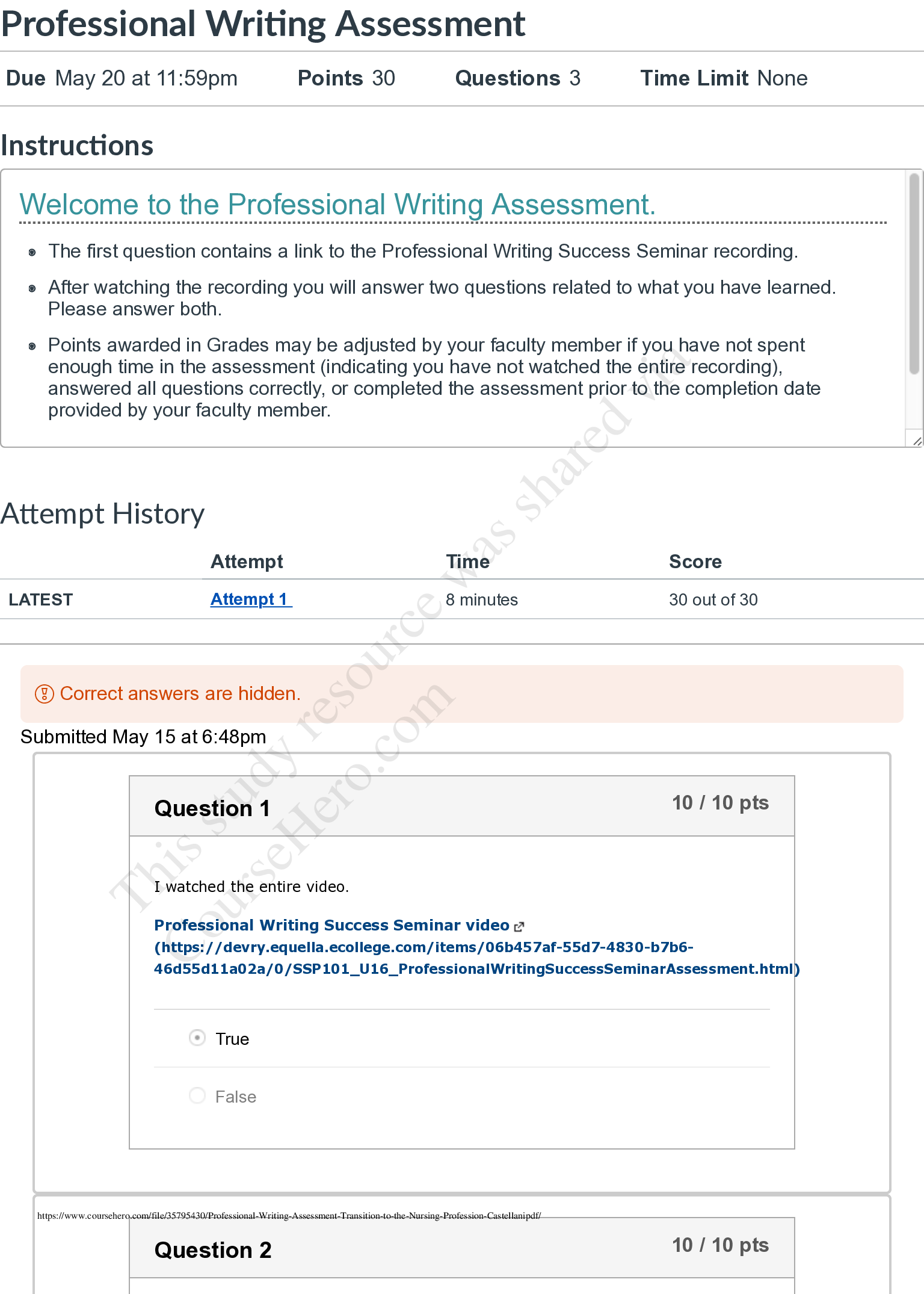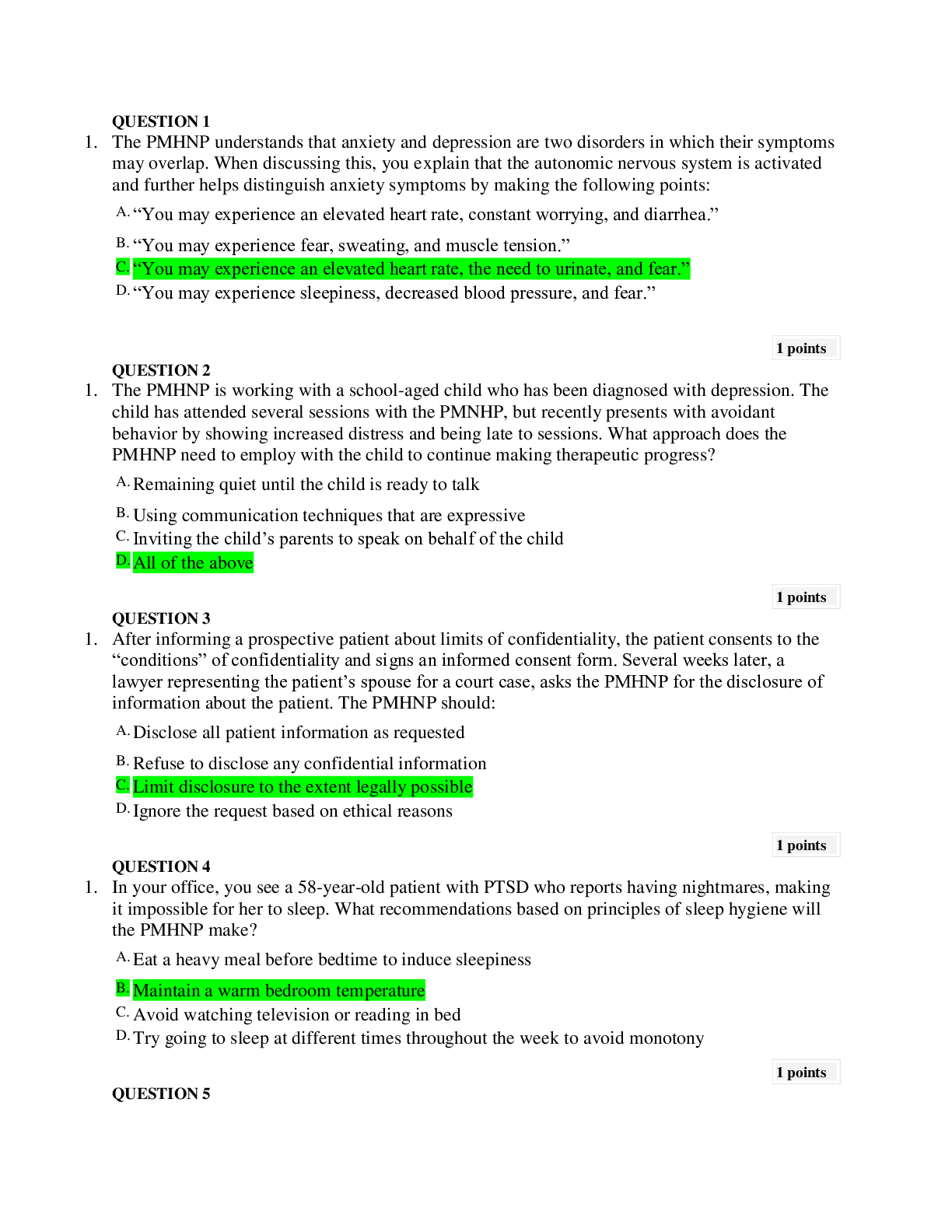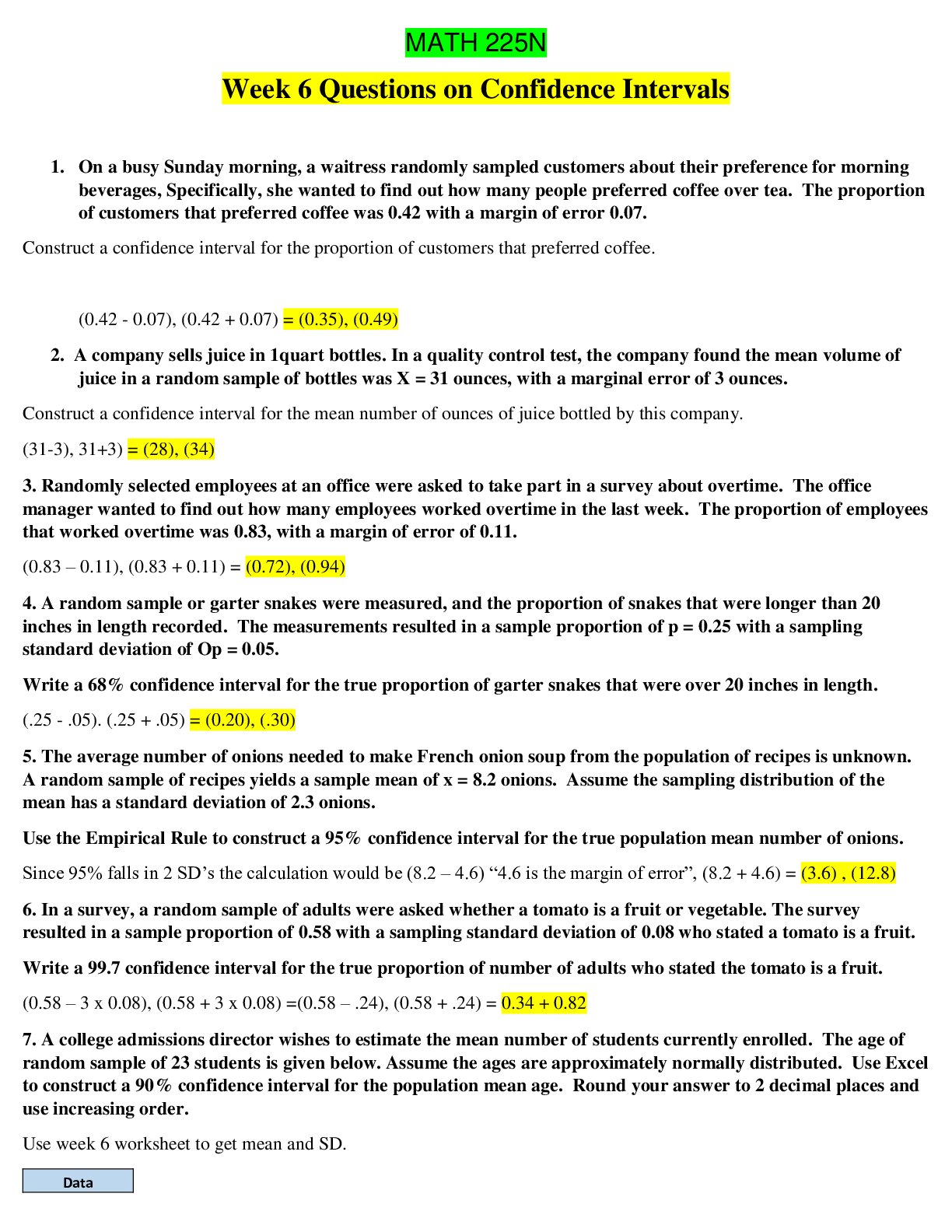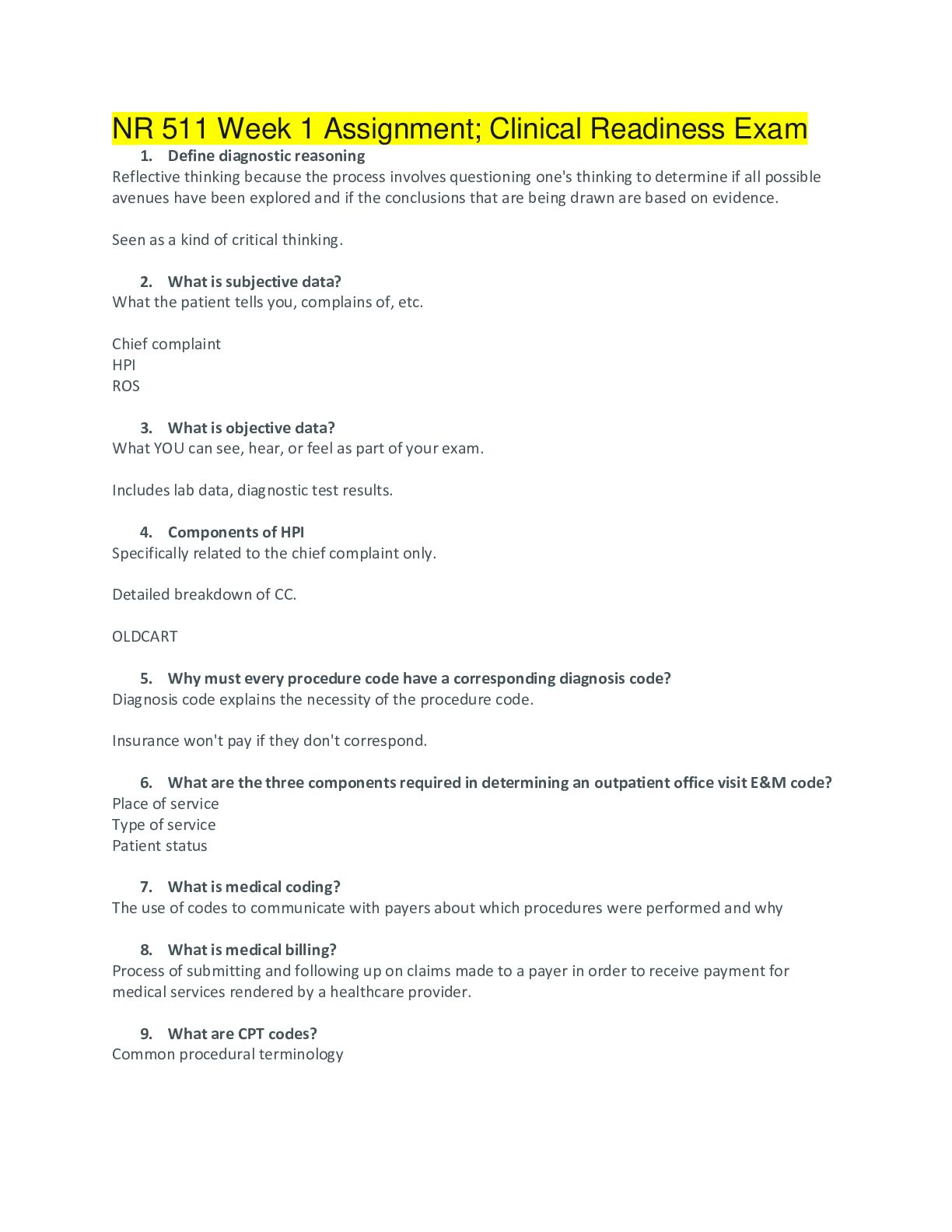*NURSING > EXAM > Chapter 16 - The Musculoskeletal System NURS 807 Questions And Answers (Latest And Complete Version (All)
Chapter 16 - The Musculoskeletal System NURS 807 Questions And Answers (Latest And Complete Version 100% )
Document Content and Description Below
Bates’ Guide to Physical Examination and History Taking, 11th Edition Chapter 16: The Musculoskeletal System Multiple Choice 1. You are assessing a patient with joint pain a... nd are trying to decide whether it is inflammatory or noninflammatory in nature. Which one of the following symptoms is consistent with an inflammatory process? A) Tenderness B) Cool temperature C) Ecchymosis D) Nodules Ans: A Chapter: 16 Page and Header: 575, The Health History Feedback: Tenderness implies an inflammatory process along with increased temperature and tenderness. 2. You are assessing a patient with diffuse joint pains and want to make sure that only the joints are the problem, and that the pain is not related to other diseases. Which of the following is a systemic cause of joint pain? A) Gout B) Osteoarthritis C) Lupus D) Spondylosis Ans: C Chapter: 16 Page and Header: 578, Joint Pain and Systemic Disorders Feedback: Lupus is a systemic disease, one symptom of which may be joint pain. It is important to consider the presence of a systemic illness when a patient presents with arthritis. 3. A 19-year-old college sophomore comes to the clinic for evaluation of joint pains. The student has been back from spring break for 2 weeks; during her holiday, she went camping. She notes that she had a red spot, shaped like a target, but then it started spreading, and then the joint pains started. She used insect repellant but was in an area known to have ticks. She has never been sick and takes no medications routinely; she has never been sexually active. What is the most likely cause of her joint pain? A) Trauma B) Gonococcal arthritis C) Psoriatic arthritis D) Lyme disease Ans: D Chapter: 16 Page and Header: 578, Joint Pain and Systemic Disorders Feedback: Lyme disease is characterized by a target-shaped red spot at the site of the bite, which disappears, then reappears and starts spreading (erythema migrans). Lyme disease can also result in joint pain as well as cardiac and neurologic manifestations. 4. An 85-year-old retired housewife comes with her daughter to establish care. Her daughter is concerned because her mother has started to fall more. As part of her physical examination, you ask her to walk across the examination room. Which of the following is not part of the stance phase of gait? A) Foot arched B) Heel strike C) Mid-stance D) Push-off Ans: A Chapter: 16 Page and Header: 587, Techniques of Examination Feedback: The foot when it is flat is part of the stance phase of gait, not the foot when it is arched. 5. A 32-year-old warehouse worker presents for evaluation of low back pain. He notes a sudden onset of pain after lifting a set of boxes that were heavier than usual. He also states that he has numbness and tingling in the left leg. He wants to know if he needs to be off of work. What test should you perform to assess for a herniated disc? A) Leg-length test B) Straight-leg raise C) Tinel's test D) Phalen's test Ans: B Chapter: 16 Page and Header: 642, Table 16-1 Feedback: The straight-leg raise involves having the patient lie supine with the examiner raising the leg. If the patient experiences a sharp pain radiating from the back down the leg in an L5 or S1 distribution, that suggests the presence of a herniated disc. 6. A 33-year-old construction worker comes for evaluation and treatment of acute onset of low back pain. He notes that the pain is an aching located in the lumbosacral area. It has been present intermittently for several years; there is no known trauma or injury. He points to the left lower back. The pain does not radiate and there is no numbness or tingling in the legs or incontinence. He was moving furniture for a friend over the weekend. On physical examination, you note muscle spasm, with normal deep tendon reflexes and muscle strength. What is the most likely cause of this patient's low back pain? A) Herniated disc B) Compression fracture C) Mechanical low back pain D) Ankylosing spondylitis Ans: C Chapter: 16 Page and Header: 642, Table 16-1, Low Back Pain Feedback: The case is an example of mechanical low back pain; in a large percentage of cases there is no known underlying cause. The pain is often precipitated by moving, lifting, or twisting motions and relieved by rest. 7. A 50-year-old realtor comes to your office for evaluation of neck pain. She was in a motor vehicle collision 2 days ago and was assessed by the emergency medical technicians on site, but she didn't think that she needed to go to the emergency room at that time. Now, she has severe pain and stiffness in her neck. On physical examination, you note pain and spasm over the paraspinous muscles on the left side of the neck, and pain when you make the patient do active range of motion of the cervical spine. What is the most likely cause of this neck pain? A) Simple stiff neck B) Aching neck C) Cervical sprain D) Cervical herniated disc Ans: C Chapter: 16 Page and Header: 643, Table 16-2 Feedback: The patient most likely has an acute whiplash injury secondary to the collision. The features of the physical examination, local tenderness and pain on movement, are consistent with cervical sprain. 8. A 28-year-old graduate student comes to your clinic for evaluation of pain “all over.” With further questioning, she is able to relate that the pain is worse in the neck, shoulders, hands, low back, and knees. She denies swelling in her joints; she states that the pain is worse in the morning; there is no limitation in her range of motion. On physical examination, she has several points on the muscles of the neck, shoulders, and back that are tender to palpation; muscle strength and range of motion are normal. Which of the following is likely the cause of her pain? A) Rheumatoid arthritis B) Osteoarthritis C) Fibromyalgia D) Polymyalgia rheumatica Ans: C Chapter: 16 Page and Header: 644, Table 16-3 Feedback: The patient has pain in specific trigger point areas on the muscles, with normal strength and range of motion. This is an indication for fibromyalgia. 9. A 68-year-old retired banker comes to your clinic for evaluation of left shoulder pain. He swims for 30 minutes daily, early in the morning. He notes a sharp, catching pain and a sensation of something grating when he tries overhead movements of his arm. On physical examination, you note tenderness just below the tip of the acromion in the area of the tendon insertions. The drop arm test is negative, and there is no limitation with shoulder shrug. The patient is not holding his arm close to his side, and there is no tenderness to palpation in the bicipital groove when the arm is at the patient's side, flexed to 90 degrees, and then supinated against resistance. Based on this description, what is the most likely cause of his shoulder pain? A) Rotator cuff tendinitis B) Rotator cuff tear C) Calcific tendinitis D) Bicipital tendinitis Ans: A Chapter: 16 Page and Header: 646, Table 16-4 Feedback: Rotator cuff tendinitis is typically precipitated by repetitive motions, such as occurs with throwing or swimming. Crepitus/grating is noted in the shoulder with range of motion. 10. A high school soccer player “blew out his knee” when the opposing goalie's head and shoulder struck his flexed knee while the goalie was diving for the ball. All of the following structures were involved in some way in his injury, but which of the following is actually an extra-articular structure? A) Synovium B) Joint capsule C) Juxta-articular bone D) Tendons Ans: D Chapter: 16 Page and Header: 572, Assessing the Musculoskeletal System Feedback: Extra-articular structures include the periarticular ligaments, tendons, bursae, muscle, fascia, bone, nerve, and overlying skin. The articular structures include the joint capsule and articular cartilage, the synovium and synovial fluid, intra-articular ligaments, and juxta-articular bone. 11. Ray works a physical job and notes pain when he attempts to lift his arm over his head. When you move the shoulder passively, he has full range of motion without pain and there is no gross swelling or tenderness. What type of joint disease does this most likely represent? A) Articular B) Extra-articular C) Neither D) Both Ans: B Chapter: 16 Page and Header: 572, Assessing the Musculoskeletal System Feedback: This description fits extra-articular disease. Articular disease typically involves swelling and tenderness of the entire joint and limits both active and passive range of motion. This is most likely extra-articular because it affects a certain portion of the range of motion, is not painful with passive range of motion, and is not associated with gross swelling or tenderness 12. Mark is a contractor who recently injured his back. He was told he had a “bulging disc” to account for the burning pain down his right leg and slight foot drop. The vertebral bodies of the spine involve which type of joint? A) Synovial B) Cartilaginous C) Fibrous D) Synostosis Ans: B Chapter: 16 Page and Header: 573, Assessing the Musculoskeletal System Feedback: The vertebral bodies of the spine are connected by cartilaginous joints involving the discs. The elbow would be an example of a synovial joint, and the sutures of the skull are an example of a fibrous joint. 13. Which of the following synovial joints would be an example of a condylar joint? A) Hip B) Interphalangeal joints of the hand C) Temporomandibular joint D) Intervertebral joint Ans: C Chapter: 16 Page and Header: 574, Structure of Synovial Joints Feedback: The TMJ is an example of a condylar joint because it involves the movement of two surfaces which are not dissociable. The hip would be an example of a spheroidal joint and the interphalangeal joints of the hand are hinge joints. The intervertebral joints are not synovial joints at all, but rather cartilaginous joints. 14. A 58-year-old man comes to your office complaining of bilateral back pain that now awakens him at night. This has been steadily increasing for the past 2 months. Which one of the following is the most reassuring in this patient with back pain? A) Age over 50 B) Pain at night C) Pain lasting more than 1 month or not responding to therapy D) Pain that is bilateral Ans: D Chapter: 16 Page and Header: 575, The Health History Feedback: While bilateral pain can be associated with serious illness, it is not one of the “red flags” of back pain. Red flags should make one suspicious for serious underlying systemic disease such as cancer, infection, or others. This list includes: age over 50, history of cancer, unexplained weight loss, pain lasting more than 1 month or not responding to treatment, pain at night or increased by rest, history of intravenous drug use, or presence of infection. The presence of one of these with low back pain indicates a 10% probability of a serious systemic disease. 15. Marion presents to your office with back pain associated with constipation and urinary retention. Which of the following is most likely? A) Sciatica B) Epidural abscess C) Cauda equina D) Idiopathic low back pain Ans: C Chapter: 16 Page and Header: 575, The Health History Feedback: The presence of bowel and bladder symptoms associated with back pain is worrisome and should suggest impingement of nerve roots S2–S4. For this reason idiopathic low back pain is unlikely. Epidural abscess may present with midline pain which can be increased with percussion over the spinous processes. Sciatica is associated with pain which radiates into the buttocks and/or down the posterior leg in the S1 distribution. 16. Louise, a 60-year-old, complains of left knee pain associated with tenderness throughout, redness, and warmth over the joint. Which of the following is least helpful in determining if a joint problem is inflammatory? A) Tenderness B) Pain C) Warmth D) Redness Ans: B Chapter: 16 Page and Header: 576, The Health History Feedback: Pain is present in both inflammatory and noninflammatory conditions. Warmth, redness, and tenderness to palpation should lead one to consider an inflammatory etiology for the pain. 17. Pain, swelling, loss of both active and passive motion, locking, and deformity would be consistent with which of the following? A) Articular joint pain B) Bursitis C) Muscular injury D) Nerve damage Ans: A Chapter: 16 Page and Header: 576, The Health History Feedback: These features are consistent with articular joint pain, whereas the other problems are associated with extra-articular structures. 18. You are working in a college health clinic and seeing a young woman with a red, painful, swollen DIP joint on the left index finger. There are also a few papules, pustules, and vesicles on reddened bases, located on the distal extremities. This would be consistent with which of the following? A) Lyme disease B) Systemic lupus erythematosus C) Hives (urticaria) D) Gonococcal arthritis Ans: D Chapter: 16 Page and Header: 578, The Health History Feedback: The presentation of a monoarthritis in this age group should lead one to think of gonococcal disease. Skin findings are often seen in conjunction with arthritis. Lyme disease is associated with an expanding erythematous patch. Lupus is associated with a “butterfly” rash on the cheeks, while serum sickness and drug reactions can be associated with hives. 19. An obese 55-year-old woman went through menarche at age 16 and menopause 2 years ago. She is concerned because an aunt had severe osteoporosis. Which of the following is a risk factor for osteoporosis? A) Obesity B) Late menopause C) Having an aunt with osteoporosis D) Delayed menarche Ans: D Chapter: 16 Page and Header: 581, Risk Factors for Osteoporosis Feedback: Obesity and late menopause are not associated with osteoporosis. Having a first-degree relative with osteoporosis is a risk factor, but an aunt is a second-degree relative. Delayed menarche is the only choice which is a known risk factor for osteoporosis. 20. A 38-year-old woman comes to you and has multiple small joints involved with pain, swelling, and stiffness. Which of the following is the most likely explanation? A) Rheumatoid arthritis B) Septic arthritis C) Gout D) Trauma Ans: A Chapter: 16 Page and Header: 583, Examination of Specific Joints Feedback: Rheumatoid arthritis is a systemic disease and accounts for multiple symmetrically involved joints. Septic arthritis is usually monoarticular, as are gout and trauma-related joint pain. 21. Mrs. Fletcher comes to your office with unilateral pain during chewing, which is chronic. She does not have facial tenderness or tenderness of the scalp. Which of the following is the most likely cause of her pain? A) Trigeminal neuralgia B) Temporomandibular joint syndrome C) Temporal arteritis D) Tumor of the mandible Ans: B Chapter: 16 Page and Header: 587, Techniques of Examination Feedback: Temporomandibular joint syndrome is a very common cause of pain with chewing. Ischemic pain with chewing, or jaw claudication, can occur with temporal arteritis, but the lack of tenderness of the scalp overlying the artery makes this less likely. Trigeminal neuralgia can be associated with extreme tenderness over the branches of the trigeminal nerve. While a tumor of the mandible is possible, is it much less likely than the other choices. 22. A man's wife is upset because when she hugs him with her hands on his left shoulder blade, “it feels creepy.” This came on gradually after a recent severe left-sided rotator cuff tear. How long does it usually take to develop muscular atrophy with increased prominence of the scapular spine following a rotator cuff tear? A) 1 week B) 2–3 weeks C) 1 month D) 2–3 months Ans: B Chapter: 16 Page and Header: 591, Techniques of Examination Feedback: Prominence of the scapular spine occurs with generalized muscle wasting as well as with specific injuries such as a rotator cuff tear. It is easily palpable, even through indoor clothing, although the back should be exposed to make other important observations. Atrophy usually occurs several weeks following a rotator cuff tear. 23. Phil comes to your office with left “shoulder pain.” You find that the pain is markedly worse when his left arm is drawn across his chest (adduction). Which of the following would you suspect? A) Rotator cuff tear B) Subacromial bursitis C) Acromioclavicular joint involvement D) Adhesive capsulitis Ans: C Chapter: 16 Page and Header: 596, Maneuvers for Examining the Shoulder Feedback: Adduction of the patient's arm across his chest can cause pain if the acromioclavicular joint is involved. In adhesive capsulitis, this maneuver may not be possible due to limited range of motion. Subacromial bursitis would present with tenderness inferior to the acromion. Rotator cuff injury would ordinarily not be associated with pain during this maneuver. 24. Two weeks ago, Mary started a job which requires carrying 40-pound buckets. She presents with elbow pain worse on the right. On examination, it hurts her elbows to dorsiflex her hands against resistance when her palms face the floor. What condition does she have? A) Medial epicondylitis (golfer's elbow) B) Olecranon bursitis C) Lateral epicondylitis (tennis elbow) D) Supracondylar fracture Ans: C Chapter: 16 Page and Header: 600, Techniques of Examination Feedback: Mary's injury probably occurred by lifting heavy buckets with her palms down (toward the bucket). This caused her chronic overuse injury at the lateral epicondyle. Medial epicondylitis has reproducible pain when palmar flexion against resistance is performed and also features tenderness over the involved epicondyle. Olecranon bursitis produces erythema and swelling over the olecranon process. A supracondylar fracture of the humerus is a major injury and would present more acutely. 25. A high school football player injured his wrist in a game. He is tender between the two tendons at the base of the thumb. Which of the following should be considered? A) DeQuervain's tenosynovitis B) Scaphoid fracture C) Wrist sprain D) Rheumatoid arthritis Ans: B Chapter: 16 Page and Header: 604, Techniques of Examination Feedback: The “anatomic snuffbox” is found between the extensor and abductor tendons at the base of the thumb. Tenderness should make one think of a scaphoid fracture. Not only is this the most common carpal bone injury, but the poor blood supply puts the bone at risk for avascular necrosis when injured. This fracture is commonly missed on x-ray, so this is an important physical finding to support further or repeated studies. 26. Mrs. Fletcher complains of numbness of her right hand. On examination, sensation of the volar aspect of the web of the thumb and index finger and the pulp of the middle finger are normal. The pulp of the index finger has decreased sensation. Which of the following is affected? A) Median nerve B) Ulnar nerve C) Radial nerve Ans: A Chapter: 16 Page and Header: 607, Examination of Specific Joints Feedback: The pulp of the index finger is innervated by the median nerve. A decrease in sensation at this area would support a diagnosis of carpal tunnel syndrome. The pulp of the fifth finger is supplied by the ulnar nerve, and the dorsal web space of the thumb and index finger is supplied by the radial nerve. 27. A 50-year-old woman presents with “left hip pain” of several weeks duration. There is marked tenderness when you press over her proximal lateral thigh. What do you think she has? A) Osteoarthritis B) Rheumatoid arthritis C) Sciatica D) Trochanteric bursitis Ans: D Chapter: 16 Page and Header: 617, Examination of Specific Joints Feedback: Bursitis is usually accompanied by tenderness on examination. This location is consistent with trochanteric bursitis. Osteoarthritis would generally not be tender and would more likely have decreased range of motion. Rheumatoid arthritis and sciatica would not likely be tender over this area. 28. Sarah presents with left lateral knee pain and has some locking in full extension. There is tenderness over the medial joint line. When the knee is extended with the foot externally rotated and some valgus stress is applied, a click is noted. What is the most likely diagnosis? A) Torn anterior cruciate ligament B) Torn posterior cruciate ligament C) Torn medial meniscus D) Torn lateral meniscus Ans: C Chapter: 16 Page and Header: 632, Maneuvers for Examining the Knee Feedback: This maneuver is called the McMurray test. Along with the medial joint line tenderness, you should suspect a medial meniscus injury. Cruciate ligament tears should cause an anterior or posterior “drawer sign.” Although we can't rule out a lateral meniscus tear, the tenderness along the medial joint line makes this the more likely site of injury. [Show More]
Last updated: 1 year ago
Preview 1 out of 13 pages
Instant download
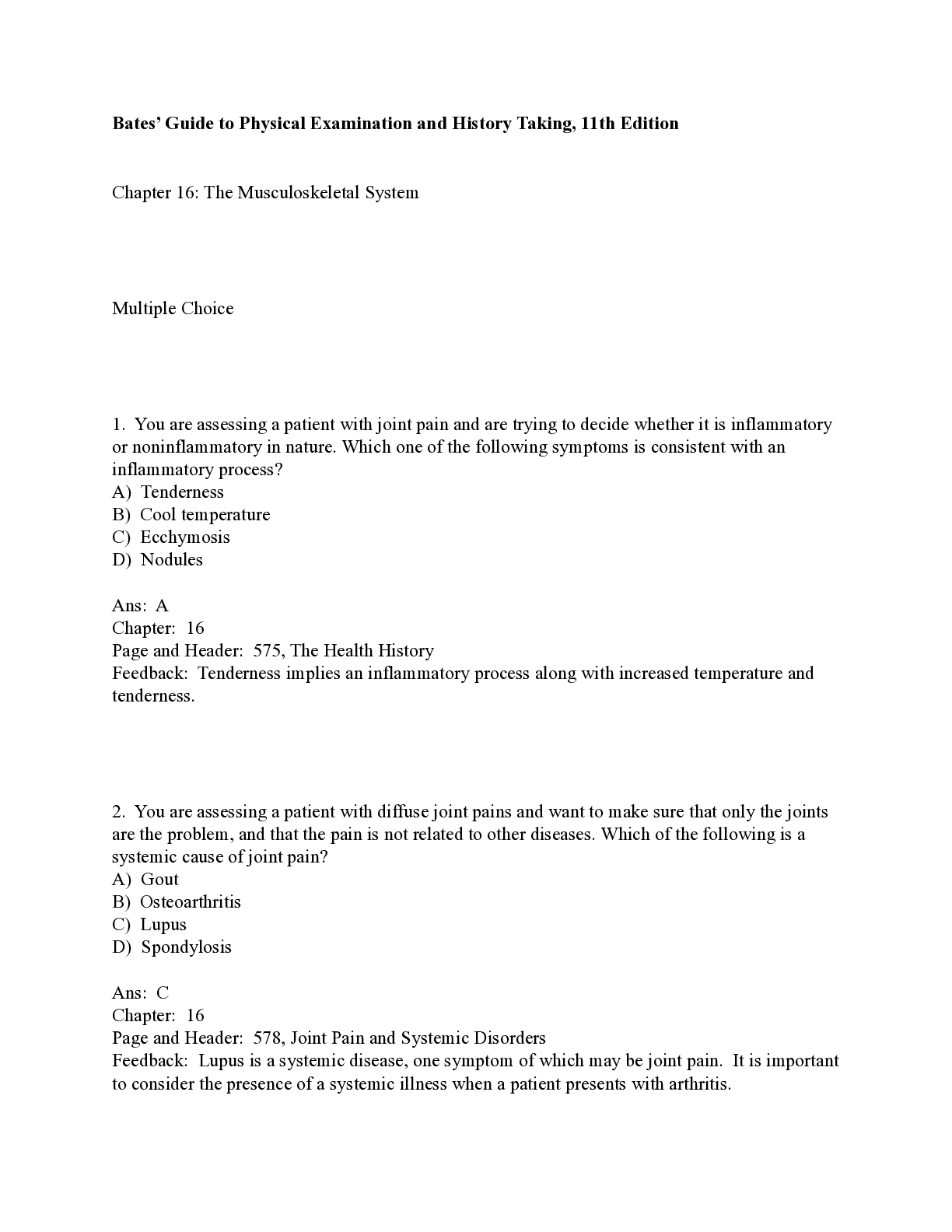
Buy this document to get the full access instantly
Instant Download Access after purchase
Add to cartInstant download
Reviews( 0 )
Document information
Connected school, study & course
About the document
Uploaded On
Dec 30, 2020
Number of pages
13
Written in
Additional information
This document has been written for:
Uploaded
Dec 30, 2020
Downloads
0
Views
34





.png)


